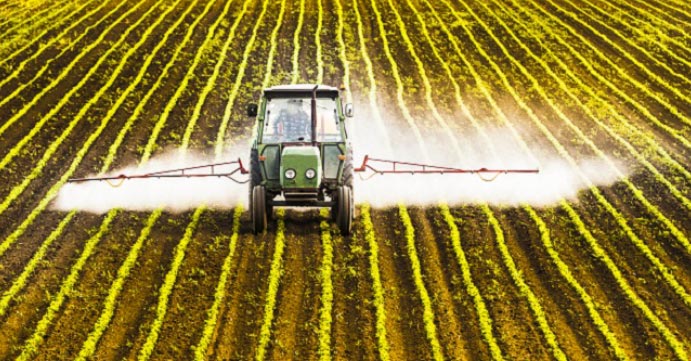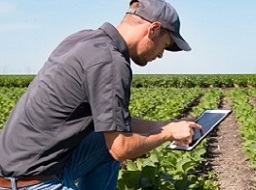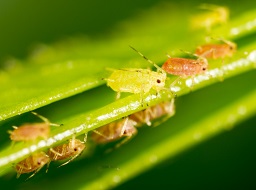Pests and diseases present a major challenge to both agriculture and our natural environment, we believe around one third of the global harvest lost to weeds, pests and diseases every year. For many years, Fera Science and its predecessors has worked with farmers, growers and agronomists to achieve more sustainable crop production while protecting the environment from the threat of diseases and pests. This has involved the development of new strategies and techniques to detect, identify, monitor and tackle both indigenous and non-indigenous threats in growing crops and stored produce. One of the things that has enabled us to better target and mitigate risks has been the data generated from the annual pesticide usage surveys (PUS). Funded from the pesticides charge on industry turnover, the PUS assesses agricultural, horticultural and amenity pesticide usage across the UK, and involves the collection of data on arable, soft fruit, orchards, vegetable and protected edible crops biennially, and grassland and fodder crops and amenity every four years. The reports, which have been publicly available since the mid-1960s, measure pesticide usage on crops in terms of area grown, area treated, weight applied, area and since the 1990’s, the percentage treated of cropped area with specific active substances, and provide a detailed insight into their changing use over time.
What do the pesticide usage surveys show?
The PUS reports demonstrate that there has been a general increase in the overall pesticide treated area, year-on-year in the UK since levels have been recorded. One of the main reasons for this is that the total area of UK farmland treated with pesticides has increased sharply. For example reviewing the data you can see that the area being treated has almost doubled between 1990 and 2015.
Significantly, the data also show that the weight of pesticides applied in the UK has decreased by approximately 50% over the same period: in 1990, the weight of active substances applied was 34,500 tonnes compared to 17,800 tonnes in 2015.


This decline in the weight of pesticides applied is more prevalent in some crops than others. For example, the weight of all pesticides applied to cereals has fallen from 15,545 tonnes to 10,912 tonnes between 1990 and 2015. This decline is largely due to changes in herbicide usage and a decreased reliance on older products applied at higher application rates (such as 2,4-D, mecoprop and isoproturon) and the introduction of sulfonyl-ureas such as metsulfuron-methyl and iodosulfuron-methyl-sodium, which are applied at significantly lower rates. There has also been a big decline in the usage of active substances on potatoes – from 12,745 tonnes in 1990 to 1,753 tonnes in 2015 – largely due to the loss of sulphuric acid as a desiccant. By contrast the usage on onions and leeks has increased from 160 tonnes to 213 tonnes (combined figures for both crops) over this period, largely due to an increased use of fungicides.

What does this range of data tell us about farmer’s and growers’ use of pesticides?
The overall decline in the weight of pesticides is due to changing practice, and the reduction in use or removal of certain active substances over time, such as sulphuric acid (as illustrated above), or methyl bromide, once used for soil sterilisation and applied at relatively high rates per hectare. Data collected by the PUS suggest that many farmers and growers are using an integrated approach to keeping pests, pathogens and weeds at bay. PUS data, as well as other sophisticated measurement techniques, have enabled Fera, as well as the government, agronomists, farmers and others to conduct more focused disease surveillance and risk forecasting, and implement effective integrated pest and disease-management strategies. Integrated crop and pest management (IPM) is something that has been practised by UK farmers and growers for many years. Certain growing practices are more amenable to IPM than others, and probably the best example is the use of pesticides in protected edible crops, such as tomatoes and cucumbers . Protected crops have been monitored by the PUS since the 1960s, and since then the use of all pesticides, particularly insecticides, has fallen and been replaced either by living biological control organisms (normally insect predators or parasites) or biopesticides. Some growers also use native bumble bees (Bombus audax), for example in tomato crops, for pollination and need to employ a delicate integrated approach to using pesticides alongside these pollinators and predators.
The pesticide usage surveys regularly sample 7% of the 4.5 million hectares of arable crops grown and between 20% - 50% of the horticultural crops surveyed.
Integrated crop and pest management (IPM) is something that has been practiced by UK farmers and growers for many years. Certain growing practices are more amenable to IPM than others, and probably the best example is the use of pesticides in protected edible crops. Protected crops have been monitored by the PUS since the 1960’s, since then, the use of all pesticides, but insecticides in particular, have fallen and been replaced either by living biological control organisms (normally insect predators or parasites) or biopesticides. Growers also use native bumble bees (Bombus audax) in tomato crops for pollination and need to use a delicate integrated approach to using pesticides alongside these pollinators and predators.
A good example of how pesticide use has changed due to changing farming and growing practices is the way in which the outdoor strawberry crop has been treated over the last 20 years. Crops were originally grown in the soil for four years, frequently following soil sterilisation with methyl bromide. Relatively small areas of the crop are now grown in soil, with most crops being grown in bags on a raised bed or table-top structure, making them less at risk from vine weevil and soil borne diseases. Strawberry crops are frequently covered with French or Spanish Poly tunnels which reduces the risk of Botrytis and the introduction of new ever-bearer varieties mean that strawberries are now cropped over several months rather than several weeks. This system requires careful management by growers to prevent pesticide residues in the harvested crop and growers do this by using a combination of conventional pesticides, biological control, biopesticides and potassium bicarbonate prior to the picking of fruit.
Field grown vegetable crops also use biological control, for example the use of Phytoseiulus persimilis in runner beans to control two-spotted spider mite. Many brassica crops, such as swedes, radish, cabbages, kale etc., are covered with an expensive mesh that prevents attack from cabbage root fly and therefore reduces the use of insecticides. Aphids and carrot fly are regularly monitored in carrot crops, using water traps and pheromone traps respectively, this helps growers better target these pests with insecticides. The same is true for vining peas where pheromone monitoring traps are used to determine whether a threshold catch of pea moths is reached. If no threshold is reached, then the crop is not sprayed; if a threshold is reached this allows the grower to better target insecticide applications using a combination of the threshold data and meteorological data.
Orchards are a much more long-term crop, with some trees monitored in the PUS being over 100 years old. There is a long history of integrated pest management in orchards with pheromone monitoring traps for codling and other tortrix moths having been used for 30-40 years. Computer-based models are also used which can incorporate meteorological data and trap catches to provide both pest and disease forecasts. In pears, one of the main pests has been the pear sucker, which can cause sticky deposits (honeydew) on the leaves and fruit which can encourage disease and can cause a loss in yield. Data collected as part of the PUS have shown increases in the use of introduced, commercially available Anthocoridae – predatory bugs which feed on the pear sucker. In addition, many growers are managing the areas around and within their orchards to encourage beneficial predators and pollinators to help with both pest control and pollination. For example, the use of earwig refuges and nesting boxes for solitary bees are frequently used.

What other factors should we bear in mind when considering pesticide usage in the UK?
When thinking about pesticide use, it is also important to remember that many of the newer active substances that have been introduced are less of a risk than those used in previous decades, replacing compounds such as organochlorine insecticides and organomercury seed treatments. We must therefore not only consider the extent of treated areas or weight of pesticides applied, but also the environment and the safety of operators and consumers. Fera tests thousands of food samples for commercial and government clients every year. Utilising the latest equipment and our knowledge of farming and growing practices, we are able to monitor residue levels in crops, identifying a wider range of pesticides at lower levels than was possible in previous decades. This has meant that compared with 15 years ago, we currently test for 10 times more pesticides, at levels typically 10 times lower . This type of monitoring work in UK and across the EU helps to ensure that risk to consumers from pesticides remains low.
For further information about the pesticide usage survey and residue monitoring, please refer to the following links:
Pesticide Usage Surveys






